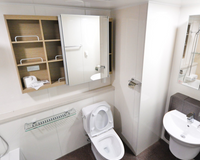Toilet partitions, also known as restroom stalls, are an essential component of public restrooms. They provide privacy and security to users while using the toilet. To ensure that toilet partitions are accessible for all users, there are specific guidelines that must be followed.
The Americans with Disabilities Act (ADA) accessibility guidelines mandate that all public restrooms, including toilet partitions, must be accessible for people with disabilities. The guidelines provide a set of standards that ensure that everyone can use public restrooms with ease and dignity. Specifically, accessible toilet partitions must have the following features:
-
Width: The stall must be at least 60 inches wide, and the door must be at least 32 inches wide, to allow for easy access for people with disabilities.
-
Grab Bars: There must be grab bars on the back and side walls of the stall. The back grab bar must be at least 36 inches long and must be located 12 inches from the centerline of the water closet. The side grab bar must be at least 42 inches long and must be located 12 inches from the back wall. These grab bars provide support for users when getting up and down from the toilet.
-
Height: The toilet seat must be between 17 and 19 inches high, and the grab bars must be between 33 and 36 inches above the floor. This ensures that users with disabilities can reach the grab bars and toilet seat comfortably.
-
Clearance: There must be at least 9 inches of clearance between the floor and the bottom of the stall door. This clearance provides enough space for a person in a wheelchair to maneuver and turn around inside the stall.
-
Accessibility Signs: There must be accessibility signs displayed to indicate that the stall is accessible for people with disabilities. These signs must be easy to read and visible from a distance.
It's important to note that toilet partitions must be designed with safety in mind. Sharp edges, corners, or protrusions should be avoided to prevent injury to users. The material used for partitions should be durable and easy to clean to prevent the accumulation of dirt and germs.
In conclusion, toilet partitions are subject to specific accessibility guidelines that must be followed to ensure they are accessible for people with disabilities. By following these guidelines, we can ensure that all users have equal access to public restrooms, and that everyone can use the facilities with ease and dignity. Accessibility is not only a legal requirement but also a moral obligation to ensure that everyone can access public spaces without any barriers.






1 comment
Charles
Is there any requirement for whether the stall door is resting with 2, 4, or 6 inches open? Or should the stall door be resting in a completely closed position?